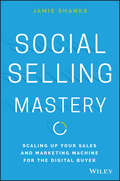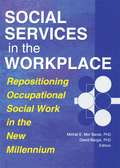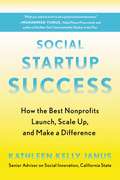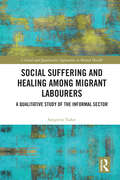- Table View
- List View
Social Security, Medicare and Government Pensions: Get the Most Out of Your Retirement and Medical Benefits
by Joseph Matthews AttorneyYour complete guide to Social Security retirement and medical benefits. If you want to get the highest possible retirement or pension income – not to mention the best medical coverage, turn to Social Security, Medicare & Government Pensions to discover the benefits you're entitled to and how to claim them as easily as possible. Navigate the complex and often daunting Social Security and Medicare systems using the resources and information in this complete guide. Learn about Medicare coverage, including Part D prescription drug coverage, and understand medigap insurance and Medicare managed care and what makes the most sense for you. And if you are denied for any medical treatment or benefits, this book teaches you how to file an appeal with Medicare, Social Security, or your state’s Medicaid agency. Also learn how to claim disability benefits, veterans benefits, and federal retirement benefits. This edition updates benefit numbers for Social Security, Medicare, and SSI for 2017.
Social Security: A Fresh Look at Policy Alternatives
by Jagadeesh GokhaleMany of us suspect that Social Security faces eventual bankruptcy. But the government projects its future finances using long outdated methods. Employing a more up-to-date approach, Jagadeesh Gokhale here argues that the program faces insolvency far sooner than previously thought. To assess Social Security's fate more accurately under current and alternative policies, Gokhale constructs a detailed simulation of the forces shaping American demographics and the economy to project their future evolution. He then uses this simulation to analyze six prominent Social Security reform packages--two liberal, two centrist, and two conservative--to demonstrate how far they would restore the program's financial health and which population groups would be helped or hurt in the process. Arguments over Social Security have raged for decades, but they have taken place in a relative informational vacuum; Social Security provides the necessary bedrock of analysis that will prove vital for anyone with a stake in this important debate.
Social Selling Mastery: Scaling Up Your Sales and Marketing Machine for the Digital Buyer
by Jamie ShanksA concrete framework for engaging today's buyer and building relationships Social Selling Mastery provides a key resource for sales and marketing professionals seeking a better way to connect with today's customer. Author Jamie Shanks has personally built Social Selling solutions in nearly every industry, and in this book, he shows you how to capture the mindshare of business leadership and turn relationships into sales. The key is to reach the buyer where they're conducting due diligence—online. The challenge is then to strike the right balance, and be seen as a helpful resource that can guide the buyer toward their ideal solution. This book presents a concrete Social Selling curriculum that teaches you everything you need to know in order to leverage the new business environment into top sales figures. Beginning with the big picture and gradually honing the focus, you'll learn the techniques that will change your entire approach to the buyer. Social Selling is not social media marketing. It's a different approach, more one-to-one rather than one-to-many. It's these personal relationships that build revenue, and this book helps you master the methods today's business demands. Reach and engage customers online Provide value and insight into the buying process Learn more effective Social Selling tactics Develop the relationships that lead to sales Today's buyers are engaging sales professionals much later in the buying process, but 74 percent of deals go to the sales professional who was first to engage the buyer and provide helpful insight. The sales community has realized the need for change—top performers have already leveraged Social Selling as a means of engagement, but many more are stuck doing "random acts of social," unsure of how to proceed. Social Selling Mastery provides a bridge across the skills gap, with essential guidance on selling to the modern buyer.
Social Selling im B2B: Grundlagen, Tools, State of the Art (essentials)
by Benedikt RömmeltDieses Open-Access-Buch bietet einen Überblick über die Grundlagen des Social Sellings und die Einordnung ins Vertriebs- und Marketingmanagement. Dazu werden Social Selling spezifische Ansätze wie Personal Branding, Employee Advocay, Content Marketing, Influencer Marketing sowie Social Listening vorgestellt. Im Fokus stehen weiterhin ein Überblick über Plattformen und Tools sowie die Diskussion von Risiken im Kontext des Social Sellings. Fallstudien zeigen, wie mit Social- Selling-Programmen Vertriebsziele erreicht werden können. Social Selling ist ein Vertriebstrend, der in den letzten Jahren aus den USA nach Europa kam. Social Selling basiert auf der Nutzung sozialer Netzwerke zum Auffinden der richtigen Interessenten, zum Aufbau von vertrauenswürdigen Beziehungen und zum Erreichen von Vertriebszielen. Im gelebten Praxisalltag boomt das Thema „Social Selling“, jedoch fehlt noch der strukturierte Überblick über dieses innovative Thema.
Social Selling: Techniques to Influence Buyers and Changemakers
by Matt Reynolds Tim HughesAs the digital landscape has changed buyers' habits it's increasingly difficult to reach them early enough in their decision-making process using traditional sales methods. Developing relationships with decision-makers through social networks has become an increasingly critical skill - enabling sales professionals to engage early on and 'hack' the buying process. Social Selling provides a practical, step-by-step blueprint for harnessing these specific and proven techniques including:- How to use networks purposefully to build social trust and create a high quality community - How to develop real influence and authority in your subject area and connect with change-makers - How to scale the social selling strategy across an organisation including maturity and investment models, risk and governance, and technology platforms.Written by Tim Hughes, a thought-leader and renowned practitioner in social selling, and Matt Reynolds, one of the UK's leading technology sociologists, this is essential reading for sales professionals, digital sales directors, and SMEs who want to embrace the power of social selling in their organisation.
Social Selling: Techniques to Influence Buyers and Changemakers
by Timothy HughesUnderstand how to reach and engage with the modern buyer using this bestseller. Social Selling outlines how to implement a social selling strategy and drive revenue, competitive advantage and market share through social networks.Social Selling is a practical, step-by-step blueprint on how to create digital communities and build and turn relationships into sales online. Featuring checklists, tips and examples providing practical guidance, it covers important subjects such as how to network purposely and build social media trust in a mistrustful time and how to develop real influence and authority in your subject area.Now newly revised, the second edition of Social Selling captures the latest changes and developments in the industry. It will be accompanied by a new introductory chapter, two new chapters on defining digital businesses and the future of sales and marketing, alongside new case studies by leading industry experts. Written by a thought-leader and renowned practitioner in social selling, Timothy Hughes, this book is essential reading for sales professionals, digital sales directors and social media executives who want to embrace the power of social selling in their organization.
Social Service, Private Gain: The Political Economy of Social Impact Bonds
by John Loxley Jesse HajerThe 2008 financial crisis and its subsequent economic impacts generated a challenge for national and regional governments across the world. From this economic ruin, the Social Impact Bond (SIB) was born as an alternative mechanism for government procurement and delivery of social public services. Social Service, Private Gain examines the evolution of SIBs, how they work, their theoretical motivation, and their global proliferation. The book critically assesses the potential of SIBs to constructively contribute to solving the multifaceted social challenges emerging from a context of entrenched and growing inequality. Claiming to bring incremental resources to the rescue, SIBs have taken up disproportionate space with new legislation, policy, subsidies, institutional supports, lobbyists, and "intermediaries" facilitating SIBs and thriving on their associated transaction costs. Drawing on mainstream and heterodox economic theory, practical case studies, and empirical data, Jesse Hajer and John Loxley generate new insights based on the limited but still suggestive publicly available data on SIB projects. Challenging the assumptions and narratives put forward by proponents of the model, they offer practical policy recommendations for SIBs and explain what the model tells us about the potential for transformational change for the better.
Social Services in the Workplace: Repositioning Occupational Social Work in the New Millennium
by David Bargal Michal E. Mor BarakDiscover the challenges and pitfalls awaiting occupational social workers in the coming years!Social Services in the Workplace: Repositioning Occupational Social Work in the New Millennium will help you meet the challenges that the rapidly changing world of work today presents. These challenges offer new opportunities for you as a social work professional in general and for the field of occupational social work in particular. Globalizing economies, downsizing, rightsizing, mergers, and corporate acquisitions continue to challenge work organizations and impact the lives of workers and their families. These trends have led to an increased need for the provision of social work services to employed, unemployed, and transitional workers and their families, and to businesses of all types and sizes. To meet the challenges facing the world of work in the 21st century, the social work profession must put special emphasis on the diverse roles that social workers can take in the workplace--from the micro to the macro--both within workplace settings and in the context of more traditional local, national and global agencies.Social Services in the Workplace proposes an expanded paradigm for social work practice in the context of the workplace, spanning the gamut from corporate and union settings to 'workfare’or welfare-to-work programs. It provides a wide array of theoretical, conceptual, and empirical examinations of evolving and innovative roles that the social work profession can fulfill in the world of work. Given today's volatile global market conditions, which dictate rapid changes in the organization and conditions of work, Social Services in the Workplace examines opportunities and dilemmas for the social work profession and points to the paths that the profession must take in the near future to remain viable.Social Services in the Workplace focuses on: defining domains for practice techniques that work and aspects to emphasize in various workplace environments provision of social work services to workers and their families welfare-to-work programs formulating organizational policies and proceduresSocial Services in the Workplace: Repositioning Occupational Social Work in the New Millennium brings into focus the practice of social work in the workplace. With this book, social work students and practitioners can gain a new perspective on the field and learn of new opportunities for employment and practice in the world of work. Academicians can use the book in their Social Work Practice classes, and researchers will discover ideas that will spark innovative research in this field. Corporate executives and human resource managers will gain a new understanding of how the social work profession can benefit their employees, their families, and the work organization. No matter which of these categories you fit into, Social Services in the Workplace will shed light on this expanding field.
Social Services of General Interest in the EU
by Erika Szyszczak Markus Krajewski Johan Willem Gronden Ulla NeergaardThe EU has limited legislative competence in the field of social law. However, the Member States are increasingly modernizing social services and social (welfare) protection, attempting to make social services more efficient by increasingly looking to the market for the provision of such services. This policy move brings social services into the radar of EU law. The EU response to this sensitive issue has resulted in a piecemeal and fragmented approach towards the treatment of a new policy area of Social Services of General Interest (SSGI) in EU law and policy. This book is a first contribution towards charting how SSGI have emerged as a special category of SGI in the EU, the reaction of the Member States and stake-holders and how policy is being made through new governance processes, carve-outs and safe havens in legislation and soft law, especially in the light of the new values of the EU introduced by the Treaty of Lisbon 2009. It takes an inter-disciplinary approach and will be of interest to lawyers, economists and political scientists who are interested in EU policy-making as well as practioners, EU and national policy-makers. Ulla Neergaard is Professor of EU law at the Faculty of Law, University of Copenhagen, Denmark. Erika Szyszczak is a Jean Monnet Professor of European Law ad personam, Professor of European Competition and Labour Law at the University of Leicester, Barrister, Littleton Chambers, UK. Johan W. van de Gronden is Professor of European Law at the Radboud University of Nijmegen, The Netherlands. Markus Krajewski is Professor of Public and International law at the University of Erlangen-Nuremberg.
Social Simulation for a Digital Society: Applications and Innovations in Computational Social Science (Springer Proceedings in Complexity)
by Johan A. Elkink Diane Payne Nial Friel Thomas U. Grund Tamara Hochstrasser Pablo Lucas Adrian Ottewill“Social Simulation for a Digital Society” provides a cross-section of state-of-the-art research in social simulation and computational social science. With the availability of big data and faster computing power, the social sciences are undergoing a tremendous transformation. Research in computational social sciences has received considerable attention in the last few years, with advances in a wide range of methodologies and applications. Areas of application of computational methods range from the study of opinion and information dynamics in social networks, the formal modeling of resource use, the study of social conflict and cooperation to the development of cognitive models for social simulation and many more. This volume is based on the Social Simulation Conference of 2017 in Dublin and includes applications from across the social sciences, providing the reader with a demonstration of the highly versatile research in social simulation, with a particular focus on public policy relevance in a digital society. Chapters in the book include contributions to the methodology of simulation-based research, theoretical and philosophical considerations, as well as applied work. This book will appeal to students and researchers in the field.
Social Spending in Mexico: Needs, Priorities and Reforms (Imf Working Papers)
by Swarnali Ahmed Hannan, Juan Pablo Cuesta Aguirre and David BartoliniA report from the International Monetary Fund.
Social Standards in EU and US Trade Agreements (The International Political Economy of New Regionalisms Series)
by Evgeny PostnikovThis book examines the causes and consequences of social standards in US and EU preferential trade agreements (PTAs). PTAs are the new reality of the global trading system. Pursued by both developed and developing countries, they increasingly incorporate labor and environmental issues to prevent a race to the bottom in social regulation and counter-protectionism. Using principal-agent theory to explore why US PTAs have stricter social standards than those signed by the EU, Postnikov argues that the level of institutional insulation of trade policy executives from interest groups and legislators determines the design of social standards. In the EU, where institutional insulation is high, social standards mirror the normative preferences of the European Commission leading to a softer approach. In the US, where such insulation is low, social standards are driven by interest groups and legislators they control, resulting in a stricter approach. This book shows that both approaches can be effective but work through different causal mechanisms. To test his argument, Postnikov draws on original data collected in Brussels, Washington, Santiago, Bogota, and Seoul. This book will be of interest to all scholars and students working in the fields of international political economy and EU and US trade policy.
Social Startup Success: How the Best Nonprofits Launch, Scale Up, and Make a Difference
by Kathleen Kelly JanusKathleen Kelly Janus, a lecturer at the Stanford University Program on Social Entrepreneurship and the founder of the successful social enterprise Spark, set out to investigate what makes a startup succeed or fail. She surveyed more than 200 high-performing social entrepreneurs and interviewed dozens of founders. Social Startup Success shares her findings for the legions of entrepreneurs working for social good, revealing how the best organizations get over the revenue hump. How do social ventures scale to over $2 million, Janus's clear benchmark for a social enterprise's sustainability? Janus, tapping into strong connections to the Silicon Valley world where many of these ventures are started or and/or funded, reveals insights from key figures such as DonorsChoose founder Charles Best, charity:water's Scott Harrison, Reshma Saujani of Girls Who Code and many others. Social Startup Success will be social entrepreneurship's essential playbook; the first definitive guide to solving the problem of scale.
Social Status and Political Participation of Rich and Poor Citizens in Africa: When the Resource-Poor are the Most Likely Voters
by Elvis Bisong TambeThis book seeks to explore a fundamental obscurity in electoral behavior literature: while socioeconomic status is typically robustly and positively associated with a higher propensity for voting worldwide, the relationship in Africa is either negative or non-existent. Building upon the author’s previous works relating to political participation, behavior and electoral processes, this work focuses specifically on 35 sub-Saharan African political system case studies and analyzes why resource-poor Africans tend to display greater electoral participation than their more comparatively affluent counterparts. Drawing from a methodological–theoretical framework utilizing Afrobarometer data and group mobilization theories such as the civic voluntarism model, electoral clientelism, democratic quality, preference theory and institutional perspectives, this book makes an original contribution to analyzing African regions less well-examined in existing comparative participatory political science literatures.
Social Stock Exchanges: Catalyst for Impact Investing? (Sustainable Finance)
by Karen WendtThis book examines funding platforms for impact investing known as social stock exchanges (SSE) and ways to approach impact investing at regulated traditional exchanges. The book analyses the antecedents and prerequisites for the successful implementation of SSEs. It presents the creation of SSEs as a necessary step towards a more democratic and popular impact investing market, and a way to align the asset search process for investors with capital access for entrepreneurs. It also analyses the installation of impact investing at traditional stock exchanges drawing from Green Bonds and Social Bonds. The book showcases successful financial structuring, integrating impact into existing financial products. It discusses standalone impact solutions, the status quo of impact investing, social entrepreneurship and the pros and cons of platforms versus the use of traditional stock exchanges for impact investing. It highlights aspects of adjusted portfolio and product structuring, innovation in the context of listing criteria and makes proposals for impact stock listings at platforms and traditional stock exchanges.
Social Strategy at American Express
by Mikolaj Jan Piskorski David ChenAmerican Express has developed a number of strategic partnerships with Facebook, Foursquare and Twitter to improve their card members experience and lower its customer acquisition cost. The case details the history of these partnerships, examines American Express' own social platforms, and talks about American Express' future plans in the realm of social strategy. It then presents students with two options related to Amex's future options and asks them to pick one.
Social Strategy at Cisco Systems
by Aaron Smith Mikolaj Jan Piskorski Daniel MalterIn April 2013, Jeanne Beliveau-Dunn, vice president and general manager for Learning@Cisco Systems, was planning the future of the Cisco Learning Network, an online platform hosted at Cisco.com. Since its launch in 2008, the Cisco Learning Network provided content to prepare networking professionals for certification exams, as well as social functionalities to let users interact with each other. To help realize the company's vision for "The Internet of Everything (IOE)," a world where nearly all physical objects, places, people, and processes were connected through the Internet, Cisco estimated that 75 to 90% of all IT workers needed to be re-skilled. The Cisco Learning Network played an important role in that process, helping to train networking professionals to design, build, and manage more complex networks. Aware of just how much was riding on the success of the learning platform, Beliveau-Dunn needed to decide whether to invest heavily in content-and have Cisco employees post videos, tutorials, and study guides to the site-or invest in more social networking tools to enable the community to produce content and help one another master the material in preparation for new certifications.
Social Strategy at Nike
by Mikolaj Jan Piskorski Ryan JohnsonNike, which first started experimenting with social media and networking in 2004, has been consistently reducing its spending on traditional advertising. Yet, Nike has not pulled back on its overall marketing budget, instead opting to focus on "nontraditional" advertising through new mediums. In doing so, the team hoped to build online communities to foster a closer relationship with its consumers. By 2012 Nike had committed to a social strategy that linked product with experience. Soon the company will discover if this strategic jump will be reflected on the bottom line.
Social Stratification in an Aging Society with Low Fertility: The Case of Japan (Economy and Social Inclusion)
by Sawako ShirahaseThis edited book empirically discusses stratification in contemporary Japanese society. It is unique for its examination of social inequality in relation to declining fertility and an aging population. Japan is the most aged society in the world: according to the Statistics Bureau of Japan, people who are aged 65 and above comprised 29.1% of the country’s total population in 2021. Meanwhile, the fertility rate has continuously declined since the mid-1970s. Japan experienced a dramatic change in its demographic structure in a short period of time. Such fast change could be a major factor that generated social stratification. In her industrialization, Japan was thought to share a pattern of social stratification similar to that of developed European and North American countries but with a low degree of socio-economic inequality and a high degree of homogeneity. There is no clear support for this description of Japan, although the country does share a pattern and degree of social stratification similar to that observed in Europe and North America. The social stratification theory has been developed in close relationship to the labor market; however, it is necessary to further examine the social stratification of very aged societies in which a substantial number of the population—namely, retired persons—no longer have any ties to the labor market. In this book, the contributors explore the pattern of social stratification at three life stages: young, middle-aged, and elderly. Included are discussions of various aspects of stratification such as education, work, wealth, marriage, family, gender, generation, and social attitudes.
Social Structure Adaptation to COVID-19: Impact on Humanity (The COVID-19 Pandemic Series)
by Suresh Nanwani William LoxleySocial Structure Adaptation to COVID-19 offers global, interdisciplinary perspectives that examine how the COVID-19 pandemic has altered the development trajectory of schools, public health, the workforce, and technology adoption. It explores social themes in society, economy, policy, and culture and draws on a social framework to describe key functions of societal adaptation to the pandemic.Edited by Suresh Nanwani and William Loxley, the volume is grounded in the study of system components and their objectives to improve overall well-being given the ill effects of the COVID-19 pandemic. Chapters explore interconnected social networks and how sectors restructured themselves to stabilize or transform society. International contributors from 20 countries offer case studies that highlight key themes including personal connectivity, societal equality, well-being, big data, and national resilience. They predict how impactful the pandemic might be in reshaping the future and assess how the COVID-19 pandemic has affected school system shutdown, public health collapse, business closures, public policy failure, and technology-driven social media acceleration.Offering insights into how institutions and sectors work together in times of crisis, and how COVID-19 has restructured social behavior, Social Structure Adaptation to COVID-19 will be valuable reading for scholars and students of sociology, political science, anthropology, comparative international development, psychology, and education. It will also be of interest to policymakers concerned with education, work and organizations, and media and technology.The Open Access version of this book, available at www.taylorfrancis.com, has been made available under a Creative Commons Attribution-Non Commercial-No Derivatives (CC-BY-NC-ND) 4.0 international license.
Social Structure and Mobility in Economic Development
by Neil J. Smelser Seymour Martin LipsetThe foundation of this volume is the notion that the several processes of change constituting economic and social development are systematically interrelated. The essence of development is the appearance of rapid rates of increases in many different indices--output per capita, political participation, literacy and the like. These quantitative changes are, however, commonly accompanied by vast changes in the social structure--markets emerge, political bureaucracies arise, and new educational systems appear. Written by the leading authorities on the subject, this group of papers tackles the causes and consequences of social mobility. Each author brings his particular skills to bear on various aspects of the problem in studies of persons moving from rural to urban settings, from one kind of industry to another and from one prestige level to another. Several of the papers review the theoretical and methodological issues involved in comparative research on social mobility while others compare and contrast traditional and modern stratification systems. Various papers explore the economic, religious and psychological basis of social mobility, concluding with enquiry into the consequences of rapid mobility, especially in terms of the political stability of developing nations. Because social mobility is a central consideration in any study of economic and social change, every student of change will use this pioneering reference source as a text for all future research. Contributors include Otis Dudley Duncan, Harold L. Wilensky, Michael G. Smith, Bert F. Hoselitz, Wilbert E. Moore, Natalie Rogoff Rams°y, Gideon Sjoberg, Reinhard Bendix, Harry Crockett, David Matza, Lester Seligman, and Gino Germani. Neil J. Smelser is emeritus professor, Department of Sociology, University of California, Berkeley. Seymour Martin Lipset was professor of sociology and director of the Institute of International Studies at the University of California, Berkeley.
Social Structure and Personality in the Factory (Routledge Library Editions: Human Resource Management #23)
by Paul LafitteThis study, first published in 1958, explores the behaviour of industrial workers in a social context. By interviewing and observing workers in factories in Melbourne, the author examines the worker’s evaluation of work, work satisfaction, relationships and friendships within the workplace, and the worker’s place in society. This title will be of interest to students of psychology, sociology and business studies.
Social Style/Management Style: Developing Productive Work Relationships
by Robert Bolton Dorothy Grover BoltonWhat is social style, and how can you make it work for you in a business situation? Your success at any management level depends largely on your ability to deal with other people. In this business-oriented approach to interpersonal relationships, management experts Robert Bolton and Dorothy Grover Bolton show you how to assess various behavior patterns and how to use that knowledge to capitalize on your strengths, minimize your weaknesses, and get the results you want from others.Are you predominantly an Amiable, an Analytical, an Expressive, or a Driver? Nearly everyone, according to Boltons' extensive research, uses on of the four basic social styles more often than the others. <p><p> No style is better than any other, but each does bring with it a unique pattern of strengths and weaknesses. This book shows you not only how to recognize your particular style but also how to use that knowledge to manage others more effectively, set appropriate life goals and career paths, plan a sound self-improvement plan, increase your creativity, and more. The best managers, claim the Boltons, excel at being what they are rather than at trying to be what they are not.If you feel that your effectiveness at work could be increased by better interpersonal skills but are tired of theories that want you to overhaul yourself to fit some uncomfortable, impersonal ""management style,"" then let Social Style/Management Style improve your dealings with others and still let you be yourself.
Social Suffering and Healing among Migrant Labourers: A Qualitative Study of the Informal Sector (Critical and Qualitative Approaches to Mental Health Experiences among Vulnerable Groups)
by Sangeeta YadavThe book uncovers the nuances of the lives of unskilled migrant labourers in India. The qualitative approach, along with the social constructivist paradigm and ethnographic fieldwork demonstrates the nature of scientific inquiry carried out in this work. The data analysis methods supporting the narratives will not only help readers understand the experiences of the migrant communities but will also facilitate a bond of empathy with the participants.Taking a bottom-up approach, the book explores how migrant labourers’ suffering, and their sense of wellbeing are deeply embedded in their existing surroundings. It throws light on the numerous communities across the world that are at high risk of developing mental health related problems due to existing socio-political conditions.The book will be useful to the students, researchers, and teachers of Sociology, Social Work, Anthropology, Psychology, Political Science, Economics, Public Policy and Administration. It will be especially be useful to mental health professionals, social workers and NGOs engaging with migrant or other marginalized communities.
Social Support Systems in Rural Italy: The Modern Age Regional States of the Northern Peninsula (Palgrave Studies in Economic History)
by Luciano Maffi Giovanni Gregorini Marco RochiniThis book examines the development of social support systems in the Modern age in the rural areas of the city-states of Northern Italy. This investigation achieves two main purposes: first, it allows researchers to understand the role occupied concretely by welfare and micro-credit activities in the political and socio-economic panorama of rural Northern Italy; secondly, it verifies to what extent the formation of a more or less structured support system influenced the establishment of local identity and the rooting of individuals. The book brings together perspectives from different fields of research ranging from economic and political history to the study of the history of ecclesiastical institutions, as well as integrating recent research on the anthropological value of welfare actions and the use of multiple historical sources. It considers how the retreat of the welfare activity of the State, associated with a depopulation of the rural areas of the peninsula and a steady increase of poverty into social fringes that were previously not affected by economic problems, pushes us to investigate more carefully the dynamics that in the Ancien Régime gave shape to the support activities against indigence and poverty. This book will be of interest to academics and students working in economic history and social history.






















